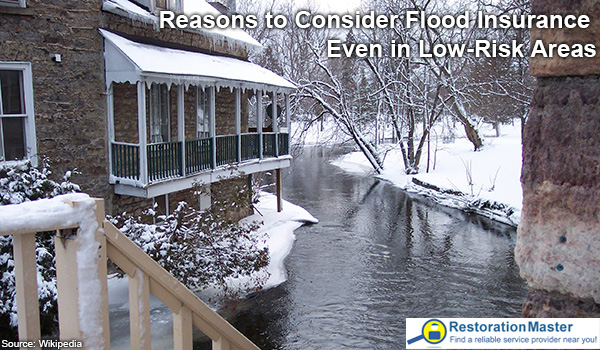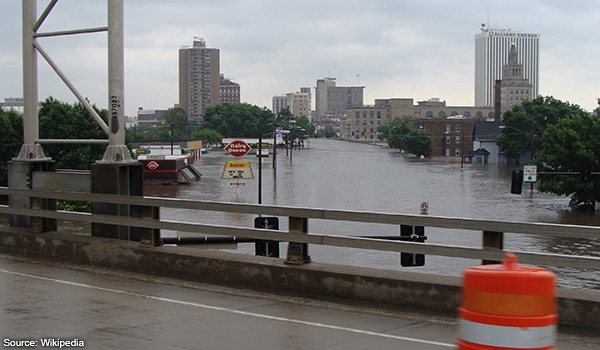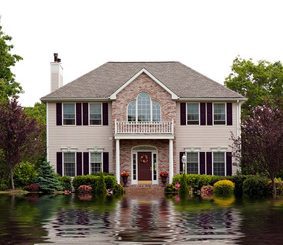Reasons to Consider Flood Insurance Even in Low-Risk Areas

This may look like a very beautiful snow picture, but it’s actually a great danger for your home.
Most homes are covered by homeowner’s insuranceHomeowner’s insurance is a policy that provides financial ... More which compensates the owner for a variety of losses and damage but what many people may not realize is that typical homeowner’s insuranceHomeowner’s insurance is a policy that provides financial ... More does not cover floods. Water damage caused by the floodingFlooding is the overflow or accumulation of water in areas t... More of groundwaterGroundwater is water that exists beneath the earth’s surfa... More, melting snow, or seepageSeepage is the slow movement of water or other fluids throug... More into your home is not covered by homeowner’s insuranceHomeowner’s insurance is a policy that provides financial ... More and is only covered by government-issued flood insurance. Flood insurance is something that a homeowner must seek and pay for separately from their homeowner’s insuranceHomeowner’s insurance is a policy that provides financial ... More and many people who live in low-risk floodingFlooding is the overflow or accumulation of water in areas t... More areas may not see the value in taking out a flood insurance policy. However, it is wise to consider adding floodingFlooding is the overflow or accumulation of water in areas t... More insurance regardless of where you live to cover flood damage restoration services if the need arises.
Important Information about Flood Insurance
Flood insurance is provided by the National Flood Insurance Program (NFIP) created by the U.S. government in response to the lack of flood coverage from standard homeowner’s insuranceHomeowner’s insurance is a policy that provides financial ... More. In order to get flood insurance through the NFIP, your community needs to adopt a floodplain management ordinance and the government will then make the insurance available to residents of the community. You can find out if your community is eligible for flood insurance by talking to your insurance agent. The following are some questions to consider when deciding to get flood insurance.
What is covered by flood insurance?

FloodingFlooding is the overflow or accumulation of water in areas t... More in Iowa in 2008
Flood insurance from the NFIP can cover damage to the structureStructure refers to the framework or components of a buildin... More of the home itself as well as to your personal property. The coverage of personal property is optional as you can opt for a plan that only includes coverage of the structureStructure refers to the framework or components of a buildin... More. It is also important to remember that in most cases, a 30 day waiting period is required so make sure you buy a policy before facing the possibility of flood damage.
What isn’t covered by flood insurance?
The following are normally not covered by flood insurance from the NFIP: buildings that are over water or mostly underground, gas and liquid storage tanks, aircraft, piers, land, roads, machinery left in the open, animals, and most vehicles. Ask your insurance agent for a complete list of what flood insurance does not cover.
What is the cost of flood insurance?
The cost of flood insurance policies is largely determined by whether you live in a high-risk or low-risk floodingFlooding is the overflow or accumulation of water in areas t... More area. Insurance premiums in high-risk areas can reach as high as $2000 per year while premiums in low-risk areas can be as low as $300-400 per year. Other factors that help determine flood insurance premiums include the age of the building, how many stories, and the deductible among others.
Why Get Flood Insurance
Homeowners in low-risk floodingFlooding is the overflow or accumulation of water in areas t... More areas may not think that floodingFlooding is the overflow or accumulation of water in areas t... More insurance is worth the cost, but between 20 and 25 percent of flood insurance claims in a year come from low-risk floodingFlooding is the overflow or accumulation of water in areas t... More areas. You do not have to live next to a large body of water to be at risk for floodingFlooding is the overflow or accumulation of water in areas t... More as heavy rains can cause home floodingFlooding is the overflow or accumulation of water in areas t... More and sometimes flash floods in inland areas. Even flood damage that does not seem serious at first can spread easily throughout a home to cause more damage to the structural elements of your home as well as your furnishings and personal belongings. An insurance agent can help you determine how much coverage to get with your flood insurance policy to adequately cover your home and personal belongings.
Even if you live in an area that does not flood often, it is wise to consider flood insurance for your home. Many areas of the U.S. that are not near large bodies of water can still be at risk of floodingFlooding is the overflow or accumulation of water in areas t... More from heavy rains, melting snow, and flash floods and the cost of flood insurance is considerably less than the cost of having flood damage repaired without insurance. If you do sustain flood damage in your home and need to hire a professional for water damage restoration, they can work within the terms of your flood insurance and help coordinate claims.












